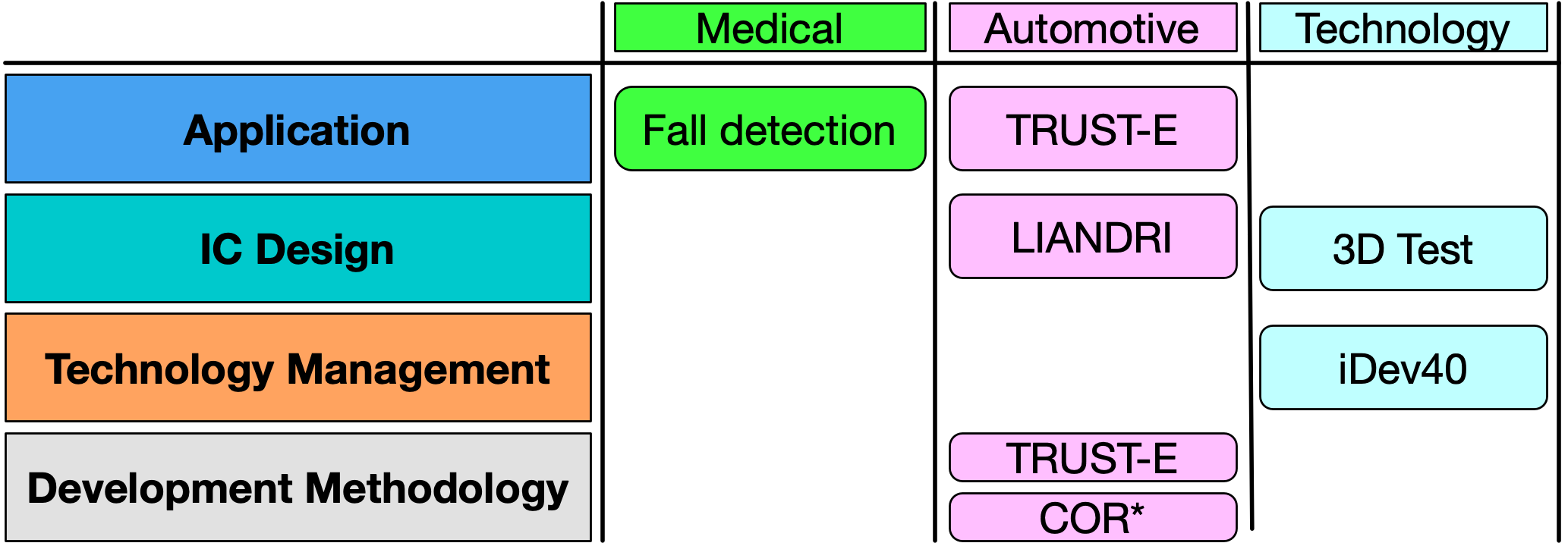Research
Digital integrated Systems form the backbone of today's socienty. Ubiquitous communication is essential, and we expect that the devices and services we use become more and more intelligent and ease our live. Our research field can be seen as matrix of domains and technology levels.
Research domains
Medical: The first domain where digitization is in full swing is medical. New devices are under development providing more sensors with a higher sensistivity. These sensors will allow the continuous monitoring of vital data, and the intelligent postprocessing and interpretation of the acquired data provides valuable data helpful for all of usis fall detection using a fingerring.
Automotive: Mobility and autonomous driving require sensor systems with advanced features. The time-of-flight LiDAR is one such system which is essential for generating a view of the streen, in addition to cameras and RADAR. Besides the advancing technology,
Technology: The group has been active in the IC design for a long time, and this is why the manufaturing and the test are core competences of the group.
Technology levels
Application: In the medical domain, we are working on fall detection of elderly people using a fingerring. This is challenging, because the hand moves much more than the center of the body which makes it difficult to distinguish movements. Sophisticated hardware and intelligent algorithms, both classical as well as Artificial Intelligence(AI)/Machine Learning(ML), must get together to master this challenge.
IC Design: A core comptence in teaching and research, IC design experience is the basis for the LIANDRI project, where we develop a high-speed/high-curent driver for controlling a power VCSEL. The driver is one of the most critical parts of a LiDAR system. Test of advanced systems means to master the challenge of stacked 3D systems. The 1838-2019 - IEEE Standard for Test Access Architecture for Three-Dimensional Stacked Integrated Circuits supporting the 3D test has been co-developed in our group. For improving an existing Electroimpedance Tomography (EIT) system, we are working on an advanced IC design which consumes less power than the senors unsing discrete components (EIT2Chip).
Technology Management: Manufacturing technology is the art of controlling a process with more than 600 subsequent steps. For the economic success it is essential to manufacture as many working ICs as possible. To predict the final yield, AI/ML methods are used which take into account the process data of previously manufactured devices and the information about the individual manufacturing steps. This approach requires the access to a manufactring database with huge amoiunts of data and is pursued in the iDev40 project.
Development Methodology: Besides the development of the technology it is also necessary to improve the way how systems are developed. Of course, the technical specifications are the core of all projects, but there are also many non functional constraints which have to be met. One aspect is cost, where obsolescence is an upcoming problem, but also reliability estimation of hierarchical systems and life cycle cost become important. Another topic, supported by the European project TRUST-E, addresses the reliability and health of components, modules, and systems.

COR: Cost, Obsolescence, Reliability
These reserach projects are exectuted in close coooperation with other research institutions and industry. In many cases, national and European projects build the framework for doing this work.They are funded by Eureka clusters, ECSEL, or the German Ministry of Education and Reserach.
